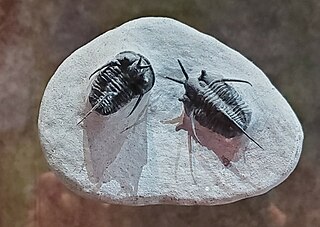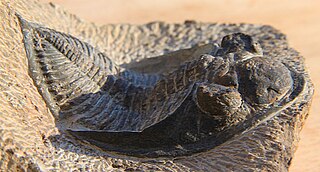
Trilobites are extinct marine arthropods that form the class Trilobita. Trilobites form one of the earliest known groups of arthropods. The first appearance of trilobites in the fossil record defines the base of the Atdabanian stage of the Early Cambrian period and they flourished throughout the lower Paleozoic before slipping into a long decline, when, during the Devonian, all trilobite orders except the Proetida died out. The last trilobites disappeared in the mass extinction at the end of the Permian about 251.9 million years ago. Trilobites were among the most successful of all early animals, existing in oceans for almost 270 million years, with over 22,000 species having been described.

Phacops is a genus of trilobites in the order Phacopida, family Phacopidae, that lived in Europe, northwestern Africa, North and South America and China from the Late Ordovician until the very end of the Devonian, with a broader time range described from the Late Ordovician. It was a rounded animal, with a globose head and large eyes, and probably fed on detritus. Phacops is often found rolled up ("volvation"), a biological defense mechanism that is widespread among smaller trilobites but further perfected in this genus.

Dalmanites is a genus of trilobite in the order Phacopida. They lived from the Late Ordovician to Middle Devonian.

Meteoraspis is an extinct genus of ptychopariid trilobites of the family Tricrepicephalidae. The various species lived from 501 to 497 million years ago during the Dresbachian faunal stage of the late Cambrian Period. Fossils of Meteoraspis are characteristic of Late Cambrian strata in North America, though they are found in Late Cambrian strata elsewhere in the world, such as M. nevensis from Victoria Land, Antarctica.

Cyphaspis is a genus of small trilobite that lived from the Late Ordovician to the Late Devonian. Fossils have been found in marine strata in what is now Europe, Africa and North America. Various species had a compact body, and a large, bulbous glabellum. Many species had long spines arranged similarly to closely related genera, such as Otarian, Otarionella, Chamaeleoaspis, and Namuropyge.
Arduennella is a Devonian homalonotid genus of trilobite in the order Phacopida, which existed in what is now Belgium, Germany, Morocco and Romania. It was described by Wenndorf in 1990, and the type species is Arduennella maillieuxi, which was originally described as Homalonotus maillieuxi by Asselberghs in 1923.
Asteropyge is an extinct genus of trilobite. It lived from the end of the Lower Devonian into the Middle Devonian, in what are today France, and Germany.
Burmeisterella is a genus of trilobites in the order Phacopida. It was described by Reed in 1918.
Geesops is an extinct genus of trilobites in the family Phacopidae. There are about five described species in Geesops.

Ceratarges was a genus of lichid Trilobite from the Middle Devonian to late Devonian. It lived in what is now western Europe and Morocco.

Aulacopleura is a genus of proetid trilobite that lived from the Middle Ordovician to the Middle Devonian. Some authors may classify this group as subgenus Otarion (Aulacopleura). The cephalon is semicircular or semielliptical, with border and preglabellar field. The glabella is short, with or without defined eye ridges connecting it with eyes of variable size. Spines at the rear outer corners of the cephalon are present, typically reaching back to the 2nd to 4th thorax segment. The 'palate' is not connected to the dorsal shield of the cephalon. The cephalon is pitted, or has small tubercles. The thorax has up to 22 segments. The pleural ends are usually rounded. The pygidium is small (micropygous), with an even margin. A. koninckii had a modern type of compound eye.

Odontochile is a genus of trilobites in the order Phacopida, family Dalmanitidae.

Geragnostus is a genus of very small agnostid trilobites whose fossils are found Ordovician-aged marine strata from Eurasia, North America and Argentina.

Acuticryphops is a genus of trilobite that lived during the late Frasnian, particularly between the Lower and Upper Kellwasser horizons. It is known from mid-European Avalonia and Armorica and the North Gondwana margin.

Placoparia is a genus of trilobites of average size that lived during the late Lower to the early Upper Ordovician on the paleocontinents Gondwana, Avalonia and Laurentia, now the Czech Republic, France, Germany, Morocco, Portugal, Spain and Wales. Its headshield is semi-circular to rectangular with rounded frontal corners. It lacks eyes, but eye ridges are present. The fact that the facial sutures are opisthoparian is an exception in the otherwise proparian Cheirurina. The thorax has 11 or 12 segments, with the axis slightly wider than the ribs to its sides. The tips of the pleurae are free, which resembles an old-fashion central heating radiator. The axis in the small tailshield consists of four rings and a minute endpiece. The four pleurae end in spatulate spines that fit to corresponding indentations in the cephalon.

Hollardops is a genus of trilobite in the order Phacopida that lived during the Devonian. Their fossils are found in the upper Emsian of western Europe and in the lower Emsian to lowermost Eifelian of North Africa. The type species, Asteropyge mesocristata, was described from Algeria by Le Maître in 1952. The genus Hollardops was erected by Morzadec in 1997. In the same year, Lieberman & Kloc erected Modellops and Philipsmithiana but those genera are regarded as subjective synonyms of Hollardops. The 10-segmented thoracic condition of Hollardops is a rare feature among acastid trilobites that almost always have 11 thorax segments. Van Viersen & Kloc (2022) revisited Hollardops and described a number of new species from the Devonian of Morocco. They also regarded Pennarbedops Bignon & Crônier, 2013 as a synonym of Hollardops. Van Viersen & Kloc construed Hollardops as a scavenger or predator with well-developed eyes, that used its shovel-like cephalon to plough the top layers of the sediment in search of food. Hollardops had small pits horizontally along the fringe of the exoskeleton; these are believed to have housed setae that allowed the trilobite to closely monitor its surroundings.
This list of fossil arthropods described in 2019 is a list of new taxa of trilobites, fossil insects, crustaceans, arachnids and other fossil arthropods of every kind that are scheduled to be described during the year 2019, as well as other significant discoveries and events related to arthropod paleontology that are scheduled to occur in the year 2019.

The Vireux-Molhain national nature reserve (RNN104) is a national nature reserve of geological and paleontological interest. It is located in the Pointe de Givet, department of Ardennes, on the border between France and Belgium. It covers an area of 1.82 ha. The site is known as Customs Wall as it is near an old customs post. This outcrop of Middle Devonian shale is notable for the quantity and good state of preservation of its fossils. Trilobites are well-represented.
Diademaproetus is an extinct genus of trilobites in the family Tropidocoryphidae. There are at least four described species in Diademaproetus.
2021 in arthropod paleontology is a list of new arthropod fossil taxa, including arachnids, crustaceans, insects, trilobites, and other arthropods that were announced or described, as well as other significant arthropod paleontological discoveries and events which occurred in 2021.














